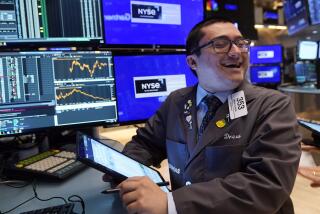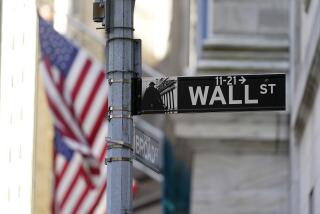U.S.-Japan Song, Dance Could Ease Currency Worries, Calm Markets
- Share via
Can Grand Kabuki help cure the world economy? Let’s hope so, because in a sense, that’s what U.S. and Japanese government officials are counting on to stop Japan’s economic decline, turn the corner on the Asia crisis--and by extension prevent a worldwide decline of currency values and a global recession.
As part of a new cooperative effort, U.S. Treasury Secretary Robert E. Rubin, Japanese Finance Minister Kiichi Miyazawa and Federal Reserve Board Chairman Alan Greenspan will meet this weekend in San Francisco.
There might not be singing and dancing, as in the stylized Japanese Kabuki tradition, but the meeting will be high theater. According to sources in Tokyo and Washington, the script will go something like this:
Rubin will voice approval for Miyazawa’s plans to deal gradually with Japan’s banking crisis and its need for economic change. This will mark a shift from the practice of Washington officials’ continually haranguing Japan for foot-dragging on reforms.
Miyazawa will pledge efforts to restore Japan’s growth and thus help the rest of Asia. He will return to Japan to try to push his bank rescue plan through a hostile parliament next week, using the evidence of U.S. support--underscored by Greenspan’s presence at the San Francisco meeting--as leverage.
Miyazawa in turn will ask Greenspan to lower U.S. interest rates so that developing nations of Asia and Latin America won’t have to keep their interest rates high to avoid devaluing their currencies.
Greenspan won’t say anything about interest rates, of course, but he will undoubtedly express support for the idea of the U.S. and Japan working together in the interests of other countries. And in the next month or so, the Fed may indeed lower U.S. interest rates as a way of easing pressure on other nations in the world economy.
For there is a serious purpose underlying the theatrics of this meeting in San Francisco. The Fed would never lower interest rates to help boost the U.S. stock market, as some have suggested in the market turmoil of this week and last. But it would to help stabilize currencies and thus the world economy.
For unstable currencies are the major threat.
“The real big worry is not the stock markets but currencies,” explains Kenneth Courtis, Tokyo-based international economist for Deutsche Bank.
The danger is of a falling yen, to 180 or even 220 to the dollar, if Japan’s economy continues to decline and its people lose all confidence in Japan’s banks. Such a weak yen would be devastating for China, South Korea, Hong Kong and the rest of Asia because it would make Japanese goods cheaper than the goods of other exporting nations.
More important, it would force Japan to call in more of its loans and investments in other Asian nations, further weakening its neighbors.
So it’s important that Japan get moving with liquidation and merging of troubled banks, as the U.S. did in the 1980s when the government merged failed Texas banks into healthy institutions such as NationsBank.
As it happens, the yen has been rising in the last week, to roughly 136 to the dollar from the 140s. The reasons are largely temporary: “Investment managers who lost money when the [Russian] ruble crashed saw a way to make profit exchanging dollars for yen,” explains Tomoko Iwakawa, currency expert for Union Bank of California. But at least some of the yen’s strength comes from traders anticipating this weekend’s San Francisco meeting.
The world’s currency worries go far beyond Japan. Mexico’s peso, for example, has fallen to a record low of nearly 10 to the dollar, reducing purchasing power for the already burdened Mexican people.
The solution in these instances is for the leading nation to ease interest rates and allow other countries to boost their economies, says Avinash Persaud, the London-based head of currency research for J.P. Morgan & Co.
The Fed must ease rates soon, Persaud says. He recalls that in 1992, Germany, the lead nation in the European Union, held back from easing interest rates and thus hurt both the British and Italian economies, forcing them to withdraw from European Monetary Union and sparking a near-recession.
When the recession threatened, Germany cut interest rates. So the Fed will have to cut rates soon or “cut them later when the U.S. economy slows down,” Persaud says.
Though stock markets are more easily understood, it is currency imbalances that have sparked caused the yearlong global economic crisis. It began in Asia with devaluations of currencies, such as Thailand’s baht.
The technical problem was that poor nations such as Thailand were trying to maintain a currency value tied to the U.S. dollar in order to control inflation in their economies. The efforts failed because most of Asia’s trade and investment relations were with Japan and its yen.
From that simple imbalance, a chain reaction of currency devaluations and headlong recessions have brought the world to the brink of global slowdown. The year’s turmoil has made countries question the wisdom of a system based on floating currencies.
Currency fluctuations impose a cost on the world economy: Every deal threatens to be undone by a swing in exchange rates.
The answer for the world ultimately is to devise a new currency system, with something closer to fixed exchange rates. Such a system would use Europe’s new euro for one region of the world, the yen for most of Asia and the dollar--the most powerful of the three--for the Western Hemisphere, predicts economist John Mueller of Lehrman Bell Mueller Cannon, an Arlington, Va., research firm.
But that system will take 10 or 20 years to emerge.
Meanwhile, as U.S. and Japanese officials try to mend the current system, we should wish them luck. If their efforts succeed, Tuesday’s big bounce in the stock market will be followed by many others. If they don’t succeed, watch out below.
*
James Flanigan can be reached by e-mail at jim.flanigan@latimes.com.
More to Read
Inside the business of entertainment
The Wide Shot brings you news, analysis and insights on everything from streaming wars to production — and what it all means for the future.
You may occasionally receive promotional content from the Los Angeles Times.










